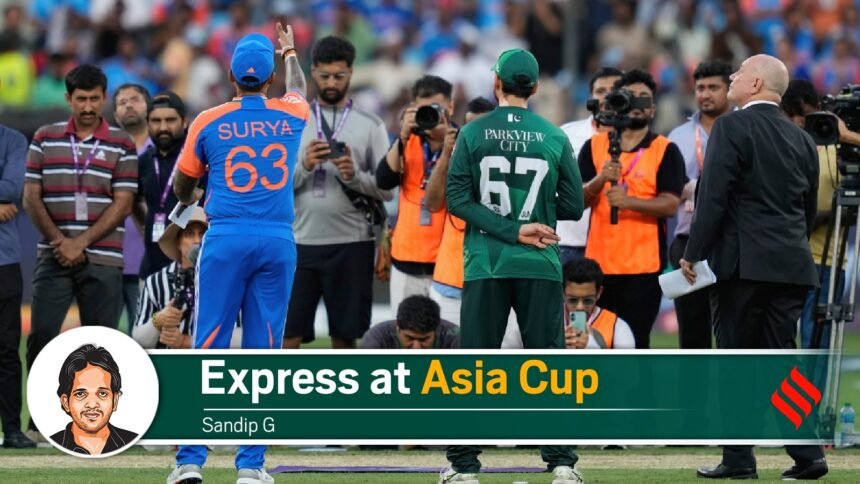A week of drama, suspense and negotiations later, India and Pakistan return to Dubai, the site that kicked off a chapter of unwanted hostility in an epic rivalry last week. Between the two Sundays, much has changed. The evenings are sweatier, the nights are cooler, tourists have begun to trickle and bask in the autumnal sunshine, Pakistan hammered the UAE, Afghanistan crashed out and Oman scared India.
Not much has changed too. India continues to be the tournament’s benchmark; Pakistan continues its pursuit of balance and ballast. This Sunday, like the previous, would be a clash of unequals. The competitiveness has lost its lustre, even though the fixture remains unmatched in hysteria in the whole wide cricketing world, a meeting with a scale and symbolism that nothing equals.
Pakistan, while rejoicing their boardroom triumph in making match referee Andy Pycroft apologise for his miscommunication in the handshake saga, is sweating on their opening combination. One of them has failed to score at all. Saim Ayub would be relieved if he averts a fourth duck in a row. The other, Sahibzada Farhan, is amongst the runs, but cannot score those runs in a brisk manner that Pakistan wants. His strike rate of 87 is archaic even in the 50-over form.
Of all the disparities between the superpowers and bottom-dwellers in the T20 hierarchy, the most pronounced is the quality of openers. All good teams have destructive openers. England have Jos Buttler and Phil Salt; Australia wields Travis Head and Mitchell Marsh; India brandishes Abhishek Sharma and Shubman Gill.
Quickfire starts lay the foundations for skyscrapers, especially on sluggish wickets where run-making becomes tougher when the ball loses its shine. Abhishek has struck at 225, and hence India has mustered an average of 60 in the powerplay overs. Contrastingly, Pakistan crawled in the first six overs. The powerplay figures read: 39/2 (UAE), 42/2 (India) and 47/1 (Oman). Ayub has devised new methods to self-destruct; Sahibzada has been checking out news bats in the ICC store, but has been unable to force the tempo of his scoring.
Pakistan is waddling through a curious phase where ammunition does not match ambition. Hard as they have been trying, the big strokes have been shy to roll off their bats. Pakistan have managed a combined tally of 15 sixes: India’s read 19, despite facing half as many deliveries as Pakistan have.
Spin supremacy
Similarly, India’s spin trio have asserted their superiority more convincingly than Pakistan’s quartet. Apart from 13 wickets, they have conceded only 4.75 runs an over. Pakistan’s have nabbed only 10, and have bled 6.03, thanks chiefly to Abrar Ahmed’s economy rate of 3.51.
Story continues below this ad
Bare stats aside, there is more variety and discipline amongst the Indian spinners. Apart from Ayub no other spinner purchased a wicket against India. Even the wickets he managed owed to India targeting him, rather than him marvelling at them. On the other hand, Kuldeep and pals split seven wickets among them; Kuldeep was adjudged man of the match for his high-end craft. Apart from Fakhar Zaman, none read his variations with certainty and adopted the perilous strategy of picking him off the surface.
A concern, though, for India is the availability of Axar Patel, who suffered a knock on his head when fielding against Oman. When trying to gobble a steepling catch, he lost his balance and banged his head on the turf. He trudged off to the pavilion, holding his neck in palpable discomfort. Though fielding coach T Dilip said there is little ado, the quick turnaround time could jeopardise his availability. There is not a replacement replica either in the squad. It would imbalance the side, weaken both bowling and batting.
On such slices of fortune hang Pakistan’s brightest chances of upending their rivals. Like late evening dew nullifying the sting of Kuldeep; or Shubman Gill half-prodding to nip-backers from left-handers, as he perished to Oman’s Faisal Shah, or Jasprit Bumrah showing rust after a one-day break.
Belief would stem from India’s laboured win over Oman. If an associate nation could, so could Pakistan. But India were in a mood to experiment, giving even the lower-order a free hit in the middle and the squad bowlers a tilt in the middle. Suryakumar Yadav sent Arshdeep Singh ahead of him in the batting order; as did Harshit Rana. But India would not offer such largesse to Pakistan. It was not a sign of a complacent approach, Surya said in the press conference. “From our batting point of view, our batters didn’t get a lot of game time. Starting from Sanju, Hardik, a lot of them, Axar, even Shivam Dube,” he dwelled on the altered batting unit.
Story continues below this ad
The return of Jasprit Bumrah and Varun Chakaravarthy would bring menace and cutting edge to the bowling cartel. To read too much into India’s game against Oman would be the biggest mistake Pakistan could make.
Equally illusory would be the belief that the no-handshake gesture could galvanise the team. Often in the past, tragedies, setbacks or a perceived sense of injustice have fuelled teams to glory. The cornered tigers metaphor is clumsily drawn. The lessons from the past are inspiring but the 1992 victors had an immensely gifted team, at least four of them retired as all-time legends, their virtues harnessed by a visionary leader. Agha is a more spartan man, and his side does not brim with the riches of Imran Khan’s The latter’s was a good team performing badly until the last group games. Agha does not possess such an array of glittering talents.
But Pakistan’s best hopes rest on individual brilliance. If Shaheen Afridi could rediscover his zip and nip; if Ayub could break the famine and spread a feast; if Fakhar Zaman could inflict more wounds on his favourite side. It is not that Pakistan cannot topple India; it is just that it would take a superlative effort, individual or collective, through both balance and ballast.








